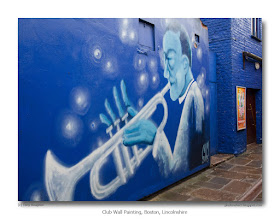I have a rule of thumb for finding photographs that is loosely based on Sherlock Holmes' advice to Dr Watson for finding the solution to a crime: "When you have eliminated the impossible", the great detective said, "whatever remains, however improbable, must be the truth." My version goes like this: "When you have photographed the obvious, whatever remains, however unpromising, must be source of your next images." With that thought in mind, on a damp afternoon, the sky a solid blanket of grey, I ventured with my wife down a few lanes and back alleys of Boston, Lincolnshire that I hadn't explored before.
Half way through our meandering walk we turned a corner and came upon a brick building that had been painted an eye-assaulting blue/purple. My first thought centred on how anyone could commit such a crime. But when I walked into the narrow alley at the side of the building I realised how and why - it was a club, and the whole purpose was to catch the eye. Well, it did more than catch my eye: it poked it sharply and provoked tears. The area is one of mainly Georgian and Victorian buildings, and the stridently painted club was like an abscess on its face. Then I spotted the trumpet player. Now I'm no fan of this sort of wall painting, but in this context, and given the desecration that had already taken place with the cans of blue/purple paint, the sight of the trumpet player was quite welcome: he lifted the building and my spirits. So I took his photograph and reflected for a moment or two on the wisdom of Sherlock Holmes.
photograph and text (c) T. Boughen
Camera: Canon
Mode: Aperture Priority
Focal Length: 40mm
F No: 10
Shutter Speed: 1/40
ISO: 1200
Exposure Compensation: -0.3 EV
Image Stabilisation: On
